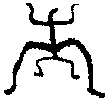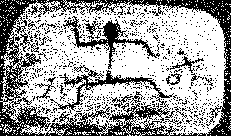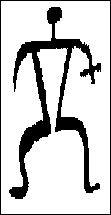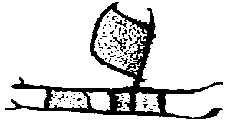|
Petroglyphs
of Hawai`i Hawaiian petroglyphs and the general cultural sanctification of stones in parts of Polynesia have not received a great deal of attention in British earth mysteries magazines, but Graeme Chappell's report on the carvings he and Paul Bennett located in Northumberland raises interesting similarities with designs found in that part of the Pacific Ocean. Elsewhere in the Pacific, it has long been remarked that the markings found in Australian aboriginal culture appear to be the nearest equivalent in style and form to British cup-and-rings marks. Although we must beware of jumping to conclusions about any similarities in meaning between native Australian, Hawaiian and prehistoric British symbolic designs, it is most curious that we should find resemblances in design over such a long distance. The following article is an account of my personal experiences with stones and carvings in Hawaii. There is life in the stone and death in the stone... This Hawaiian saying expresses the animistic sense of stone that has long enriched their culture. More than any other Polynesian sub-culture, to my knowledge, the Hawaiians have built upon their perception of stone. Their shrines, called heiau, were often built upon a sacred foundation of stones; first, the sacred area was fenced about with a dry stone retaining wall, then the interior was gradually filled in with smaller stones, compacted and finished off with a carefully laid top dressing, again of stones. Thus, a raised platform of stone separated the shrine buildings from the mundane earth; the buildings of the heiau, built of perishable materials like wood and grass, stood atop a plinth whose nature was spiritually volatile, both of the earth and beyond it. The stone platform served as the axis or mediator between Earth and the spirit world. Today, the buildings of this largely pre-Westernization religion have decayed, leaving only the scattered stone remains, some of which are as large as a football field. The heiau stood for the formalization of worship, and in particular of stone as an element in the sanctification of space. Informally, however, stones, or pohaku, were also sacralised in a number of healing stones or stones with other magical powers. Evidently an extension of this function was the association of certain sites with the birthing of babies; these and other stones were crucially concerned with the sovereignty of the land. Stones of Sovereignty Kukaniloko today is an isolated spot on a crest of land near Wahiawa on Oahu Island. Approaching it, the site of the Royal Birthing Stones is instantly conspicuous as a stand of tall pines on the skyline; the earth mysteries enthusiast, upon seeing this prospect, cannot fail to recall Alfred Watkins' association of pines with ley markers. A track leads through pineapple fields to an approximately circular area dotted with stones of various shapes and sizes. Many have carvings incised upon their surface; some are cup-marks, others geometric designs and others representational pictographs. Stones for Birthing
Not surprisingly, tradition and historical event associate these with the Royal Birthing Stones at Kukaniloko. One story tells of two sisters who lived on Kauai Island (where another birthing site existed at Wailua) and decided to visit Kukaniloko. Being possessed of magical powers during the hours of darkness, they attempted to fly there one night, but were caught by the first rays of the sun near their destination and, dropping by a stream, turned into stones. There they lay until the early years of this century, when a road was being developed through the gulch. A large stone was pushed to the side of the road; but that night the foreman, a white man named George Galbraith, had a dream in which a stone repeatedly said to him "you have my feet up and my head down, please turn me around". Returning to the construction site the next day, Galbraith recognised the stone and had it turned over. Two old Hawaiian men who helped with this told him that this stone was named Kaniniulaokalani and held a spirit that should be cared for. Galbraith then arranged for this stone (and its companion, which does not feature in this part of the story) to be taken to Kukaniloko. So perhaps the sisters finally completed their journey. However, in the light of my own powerful experience at Wahiawa, it may be speculated that the 'shoe' stone at least had been previously removed from Kukaniloko, where it had been the principal birthing stone, and was just being returned there; or that it had previously been a principal stone at Wailua on Kauai, giving rise to the tale of the sisters. However, that was not the end of journeying for the Wahiawa pair. In 1925, they were included in a rededication ceremony at the Birthing Stones, and around the same time began to feature in a number of reports of inexplicable cures. The stones became a centre of pilgrimage, with the taller of the two receiving most attention for its healing power. Finding the site, with its new-found popularity, hard to maintain, the Daughters of Hawaii decided to remove the stones - one story has it that the taller stone broke into pieces when excavation began, but was reconstituted with cement, although that was not evident when I saw it. The stones were taken to a cemetery in Wahiawa and became even more popular; the smaller stone even developed a reputation of having special healing powers for women and toddlers. People came from miles to visit them; stalls selling leis, the flower garlands of Hawaii, sprang up, there would be prayers spoken, and offerings left - apparently up to a thousand dollars a month in 1927! The popularity of the site declined in the curfews and rationing of the Second World War; the cemetery became the site of a suburban housing development, and in 1948 the stones were given the protection of their little hut. I had a hard time in 1988 finding residents who knew of and could direct me to the stones, but when I finally located them, they obviously had lost none of their accredited power to speak to the unconscious and work beneficially upon the human body. In this case, indeed, the 'energy', if I may call it that, is evidently part of the stones themselves and not consequent upon the place where they are found. At Kauai's Wailua, the birthing stones lie in a sacramental complex of sites including a regal palace and a sacrificial heiau. Pohaku-Ho-O-Hanau is the birthing place, and nearby is the Bell Stone, which gave out a loud and resounding chime when pounded to announce the birth of a royal child. Interestingly for earth mysterians, all these places are located along the King's Highway, a sacred thoroughfare used only by the island monarchs; however, I have not been able to visit Wailua and have been unable to ascertain if they constitute an alignment (further research is in progress). Other birth stones in the islands
are the Pohakuloa Stone at Punahao School gates in Honolulu and the Naha
Stone in Hilo, which was associated with sovereignty in another way too;
anyone moving its massive bulk would become ruler of all the islands,
and indeed one person who did just that in his youth went on to become
King Kamehameha, the warrior who did indeed unite all the islands under
his kingship in 1810. Calendrical Stones The Puna district of Hawaii Island, where the Pu'u Loa petroglyph field is located, has several stones which are associated with calendrical observation. One menhir is known as Kumukahi, while another is named Makanoni and is said to be a wife of Kumukahi; at summer solstice, the sun shone on Kumukahi, but moved towards Makanoni as the autumn approached. Then, when it reached another stone 'wife', Kanono, situated in the sea, the year had come to the winter solstice. Yet another 'wife' of Kumukahi, Paupoulu, marked the summer solstice, perhaps more accurately than Kumukahi himself. These are not all the 'wives' to be found in the area. The names given to the stones translate with calendrical implication - for instance, as 'autumn leaves' or 'sunrise' - and there is understandable speculation that this site, which was also known as a place of healing, was used to calculate solstices and equinoxes. The Wizards of Waikiki
An important feature of these wizards was that, despite their "manly stature", they were feminine in their habits, which seems to suggest cross-dressing and other gender-breaking attributes commonly associated with certain shamanic practices. More recent legends describe Kapaemahu and Kapuni as male healers and the other two as female magical specialists. A cycle of traditional stories describe how the stones were chosen, transported and erected to commemorate these magicians, then under their direction placed and given special powers in a series of rituals that lasted a full lunar cycle. They were moved around 1907 by Governor Cleghorn, and placed as historical items on his grounds nearby. His will stipulated that they not be removed again, but in fact they were offered to - and refused by - the Bishop Museum and then moved and damaged in the construction of a bowling alley in 1941. They were lost until demolition of the bowling alley in 1958, when first Kapaemahu and then the other three stones were found. In 1963, they were buried in the beach, but were moved again in 1980 fifty feet along the beach to their present location. Although they were then consecrated with both Hawaiian and Christian ritual, the only public attention they were receiving when I saw them eight years later was as a convenient rest for surfboards. Other Sacred Stones I have already mentioned the Naha Stone in Hilo, which the future King Kamehameha overturned in his youth. This wasn't the only megalith the great warrior hefted - he also carried Kamehameha Rock, a few miles from Hilo, from the sea. Here again we see a historical figure's heroic exploits causing a transition to semi-divine status, mirrored in his association with timeless legends and places of natural mana. In Lahaina on Maui, the Hauola Stone, poised on the shore-edge and washed by the incoming waves, was used for healing. On a different tack, Molokai's Kalaupapa Peninsula is home to a tall phallic stone where it is said a woman will become pregnant by the relatively effortless expedient of bringing a gift and spending the night there. Also on Molokai is the Whispering Stone, which was sought out by fishermen asking for good fortune. Also worth mentioning here would be a slightly different spot, Kauai's Holed Mountain, near Anahola, created when an angry giant threw a spear through it. These are only a few of the stones which figured in the folk and religious beliefs of the native Hawaiians. The beliefs largely died out during American colonial influences in the nineteenth and the first half of the twentieth centuries, and many of the heiau and pohaku are neglected and keep their atmosphere to themselves; yet, as I found, some still possess an intensity of otherworld presence that profoundly affected me. Secularisation and tourism can cause the extra-ordinary presence of a sacred place to retreat; but under certain conditions, when perhaps both time and place coincide with our own natures, we may be reminded in no uncertain terms that the energies of the Earth are not absent, but merely held in reserve. Rain God at Iao - a personal experience
On the largest of these stones I seemed to see a face, uncouth and slightly bestial, with small eyes, a protruding nose or snout and a wrinkled expression. The predominant vegetation was the ti plant, whose leaves are still used in folk rites and are left, wrapped around a stone, as offerings on sacred stones all around the islands. The atmosphere affected me very strongly, and I spent some time there meditating, making what I hoped would be accepted as friendly contact with the spirits of the place, and also asking for permission to take photographs. I noted that I didn't feel I received unequivocal permission for the photographs, but - as I hadn't received an unequivocal refusal either - I took some anyway. It had been a wet and gloomy day, and while I was at the heiau the rain started to fall heavily, crashing on the forest canopy above till it poured through on to the undergrowth, on to myself; to add to the violence of the rain, a strong wind blew up and steadily increased as I left the shrine and made my way back through the sodden forest. A river rushed noisily along beside the path; the torrential rain on the forest added to that tumult, so that I seemed to be walking within the sound of water itself. I stopped to rest and shelter beneath a large spreading tree beside the river; a rock in mid-stream poked out of the waters, and as I looked at it I saw the same rough face, looking towards me, that I had seen on the large stone in the heiau. Although I stayed there some time, the impression of the face did not go away. In due course, I found myself back at the Needle car park, and went into the rest room to try and dry out a little before walking down from the mountains. I put my camera on a ledge, took off my raincoat, and turned back just in time to see the camera tip itself off the ledge and fall on the end of the lens on the concrete floor, smashing the filter and impacting it into the screw thread so that I could neither get the broken filter off, nor put on any other filter... I have to say that I was not especially surprised by this, nor by the fact that the last photos to come out on that roll were those of the 'guardian' on the stone.
So - a sacred place, a recurring bestial face, some of the wildest weather I've ever walked through, and curious goings-on with my camera... is it any wonder that I came away from that day feeling that I had awoken Lono/Kamapua'a, and that he had made his presence known to me so insistently that I could not dismiss the experience as mere coincidence? Disturbing as it was at several points, the experience affirmed how, when dealing with earth mysteries concerns, one is dealing with a far wider territory than that satisfied by academic research; intense personal experience is part and parcel of earth mysteries, and can teach one more than the most rigorous research. For instance, how there is life in the stone, and death in the stone.... Notes |
|
|
|
|
|
|
||
| History | Atlas | Culture | Language | Links |
 When Kukaniloko was in use as a
birthing place, there was a large stone that would have supported the
mother in a semi-sitting position flanked by two rows of eighteen stones
each, credited with the power to absorb pain. A chief was required to
stand before each one. A child born thus would be called "a chief
divine; a burning fire". The placename itself means 'an inland area from
which great events are heralded'1.
When Kukaniloko was in use as a
birthing place, there was a large stone that would have supported the
mother in a semi-sitting position flanked by two rows of eighteen stones
each, credited with the power to absorb pain. A chief was required to
stand before each one. A child born thus would be called "a chief
divine; a burning fire". The placename itself means 'an inland area from
which great events are heralded'1.  Curiously, before I knew of the
story behind Kukaniloko, I visited two stones now standing in a small
concrete hut or shrine in Wahiawa. One is a tapered standing stone about
six feet tall, and the other is shaped like a heavy shoe or a reclining
chair, about four feet high. I felt compelled to hug the taller stone,
and felt a sense of great well-being come over me. As for the other
stone, its inviting shape called me to sit on it - and at once my mind
was flooded with images of birthing and that this stone related to
women. I soon removed myself, but noted not only that the shape of the
stone supported a body in great comfort, but that its edge lay where the
loins of a person, of my short stature at least, would naturally come to
rest.
Curiously, before I knew of the
story behind Kukaniloko, I visited two stones now standing in a small
concrete hut or shrine in Wahiawa. One is a tapered standing stone about
six feet tall, and the other is shaped like a heavy shoe or a reclining
chair, about four feet high. I felt compelled to hug the taller stone,
and felt a sense of great well-being come over me. As for the other
stone, its inviting shape called me to sit on it - and at once my mind
was flooded with images of birthing and that this stone related to
women. I soon removed myself, but noted not only that the shape of the
stone supported a body in great comfort, but that its edge lay where the
loins of a person, of my short stature at least, would naturally come to
rest. Honolulu's famous Waikiki Beach, with its hotels, cafes and other
touristy detritus catering largely for Japanese tourists and honeymoon
couples, is not the most obvious place to seek out sacred stones. Yet
one can find the four large stones named Kapaemahu, Kahaloa, Kapuni and
Kinohi nestling in a stand of palm trees (which seem to bend away from
the stones) on the sand. They are said to contain the spirits of four
wizards, or kahuna, who came to the island from Tahiti at some point
before the 16th century.
Honolulu's famous Waikiki Beach, with its hotels, cafes and other
touristy detritus catering largely for Japanese tourists and honeymoon
couples, is not the most obvious place to seek out sacred stones. Yet
one can find the four large stones named Kapaemahu, Kahaloa, Kapuni and
Kinohi nestling in a stand of palm trees (which seem to bend away from
the stones) on the sand. They are said to contain the spirits of four
wizards, or kahuna, who came to the island from Tahiti at some point
before the 16th century.  Perhaps the strongest experience
I had in looking about some of the sacred places of Hawaii was at Iao
Needle on Maui Island. The placename Iao means 'supreme light' - the
1200-ft. pinnacle of basalt known as the Needle is one of the more
conspicuous foci of a sacred valley, and it is this which the tourists
drive or are bussed in to see. I broke off from the tour I was booked on
as soon as we arrived here, deciding to explore the area further, and
was drawn off along a narrow track into the surrounding forests. After a
while of walking with no real aim of my own, I found myself stood in
front of a boulder on which was carved a figure which suggested to me,
with its 'halo', bent knees
and
general posture, a wizard or magical guardian. A path led away from the
stone, and some way along this path I found myself entering the
atmosphere of a sacred place; Soon after I came upon the ruins of a
severely overgrown heiau, with its stone platform and several large
stones, all enclosed with stone walls.
Perhaps the strongest experience
I had in looking about some of the sacred places of Hawaii was at Iao
Needle on Maui Island. The placename Iao means 'supreme light' - the
1200-ft. pinnacle of basalt known as the Needle is one of the more
conspicuous foci of a sacred valley, and it is this which the tourists
drive or are bussed in to see. I broke off from the tour I was booked on
as soon as we arrived here, deciding to explore the area further, and
was drawn off along a narrow track into the surrounding forests. After a
while of walking with no real aim of my own, I found myself stood in
front of a boulder on which was carved a figure which suggested to me,
with its 'halo', bent knees
and
general posture, a wizard or magical guardian. A path led away from the
stone, and some way along this path I found myself entering the
atmosphere of a sacred place; Soon after I came upon the ruins of a
severely overgrown heiau, with its stone platform and several large
stones, all enclosed with stone walls.  The rain and wind continued as I walked back down the valley, nearly
getting run down at one point when the weather obscured the vision of
both myself and an oncoming car driver. However, in the nature of
Hawaiian weather, things eased off towards the foot of the mountains,
and at the edge of Wailuku town I came across the Bailey House local
history museum. I was in for more surprises - a small boulder laid on a
windowsill 'looked' at me with the same face as I had seen on the stones
in the mountains! Beside it was a notice, which I took at first to
relate to this stone; as it happens, it related to a wooden image which
was actually on the other side of the stone, two exhibits away from the
notice, but the information it gave rang a little too true to me for
coincidence. It described the god Kamapua'a, a half-man, half-pig figure
who is one one of the aspects of the wider Polynesian deity, Lono (known
elsewhere in Polynesia as Rongo, meaning 'sound'). Lono is a deity of
agriculture and fertility, and also of wind, rain and dark rain clouds.
Among his attributes are the sound of wind, rain and sea (and, perhaps,
rushing rivers?). Kamapua'a himself is credited with creating valleys
and opening springs as he roots around with his pig snout.
The rain and wind continued as I walked back down the valley, nearly
getting run down at one point when the weather obscured the vision of
both myself and an oncoming car driver. However, in the nature of
Hawaiian weather, things eased off towards the foot of the mountains,
and at the edge of Wailuku town I came across the Bailey House local
history museum. I was in for more surprises - a small boulder laid on a
windowsill 'looked' at me with the same face as I had seen on the stones
in the mountains! Beside it was a notice, which I took at first to
relate to this stone; as it happens, it related to a wooden image which
was actually on the other side of the stone, two exhibits away from the
notice, but the information it gave rang a little too true to me for
coincidence. It described the god Kamapua'a, a half-man, half-pig figure
who is one one of the aspects of the wider Polynesian deity, Lono (known
elsewhere in Polynesia as Rongo, meaning 'sound'). Lono is a deity of
agriculture and fertility, and also of wind, rain and dark rain clouds.
Among his attributes are the sound of wind, rain and sea (and, perhaps,
rushing rivers?). Kamapua'a himself is credited with creating valleys
and opening springs as he roots around with his pig snout.